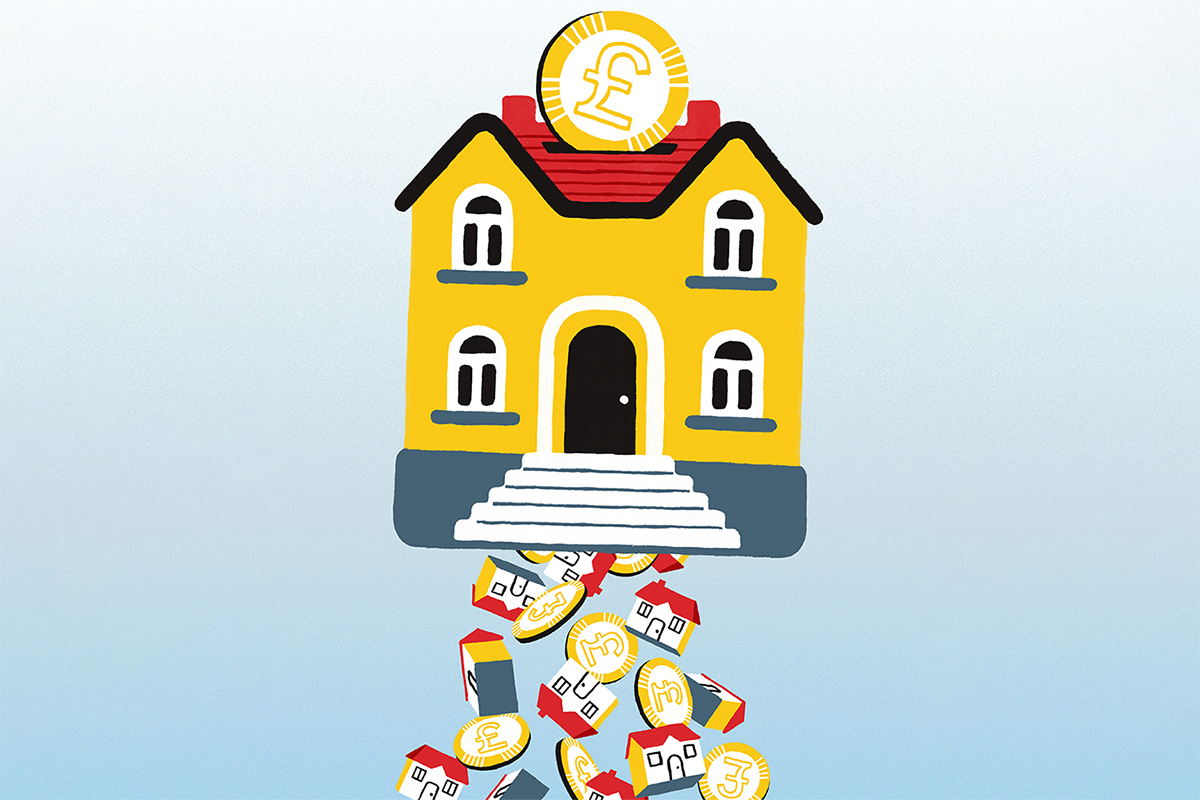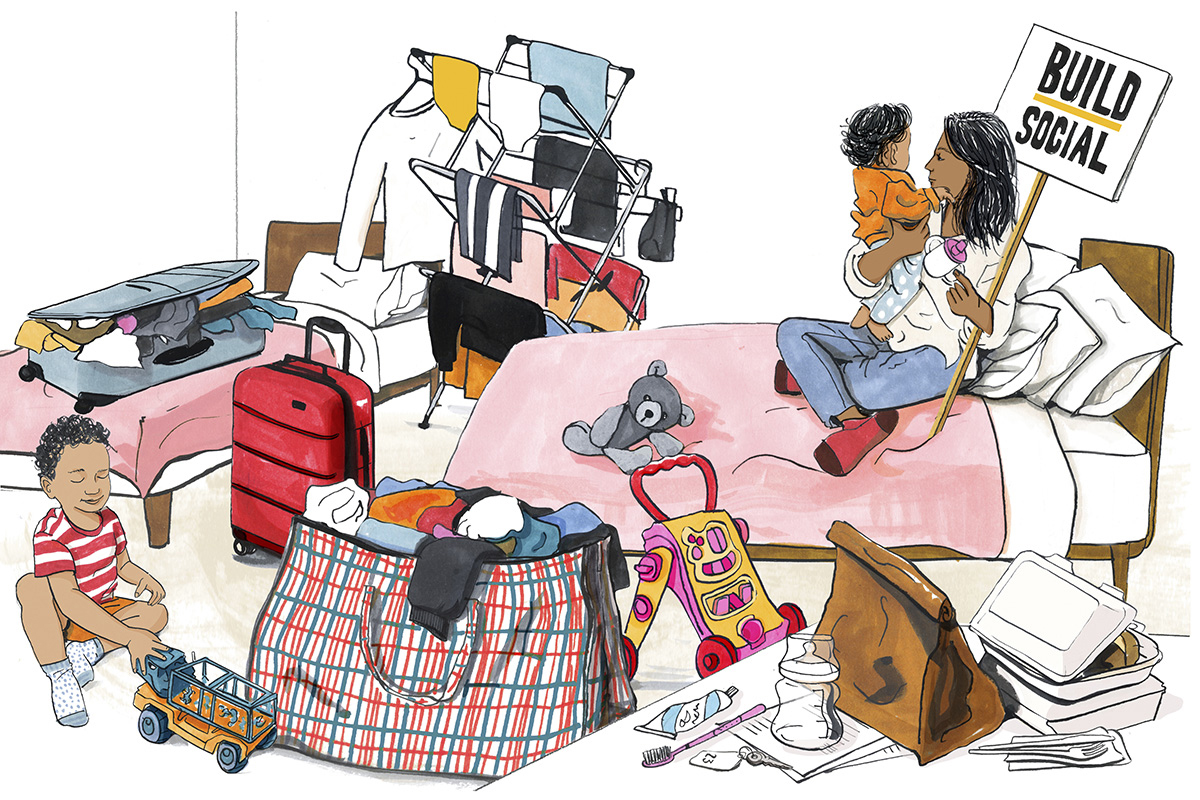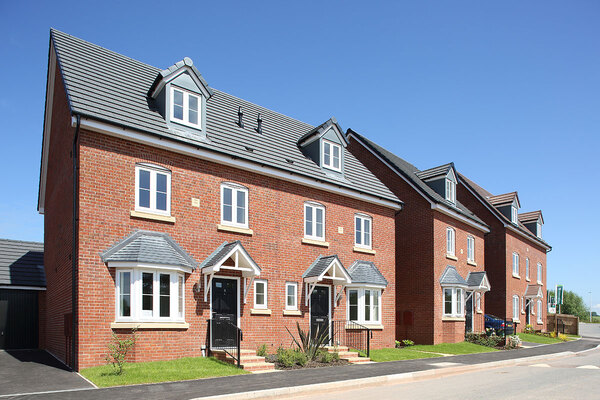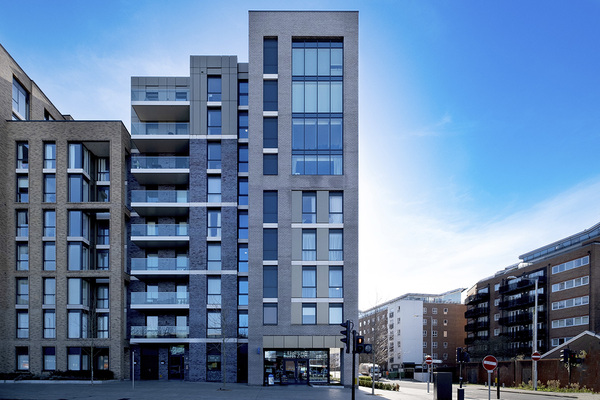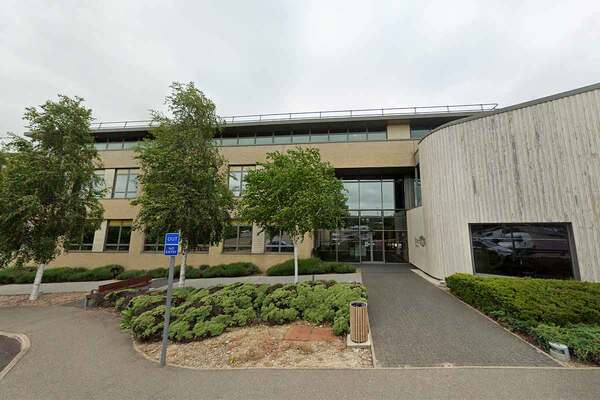You are viewing 1 of your 1 free articles
The enduring economic case for Build Social
Inside Housing’s Build Social campaign is calling for the UK to build 100,000 social rent homes a year. But how much would it cost? What would the economic impact be? And can the country afford it? Peter Apps reports. Illustration by Michael Parkin

It isn’t hard to make a social case for social housing. Whether it is the ever-lengthening housing waiting lists, increasingly unaffordable private rents, or the terrifying rise in homeless families over the past decade, plenty of numbers point to the need for much more affordable housing.
The problem is paying for it in an era of soaring build costs, higher interest rates and vast state debt, following the pandemic and last year’s energy bill relief.
As Inside Housing’s Build Social campaign calls on politicians to commit to 100,000 social rented homes a year across the UK, it is important to ask: can the country really afford this commitment?
There is no point sugar-coating the state of public finances. The country’s debt rose to £2,537bn at the end of the last financial year – more than 100% of GDP for the first time since 1961.
Both the Conservatives and Labour have committed to getting this debt down, which means new spending will have to come from new taxes, which neither is keen to impose.
It is becoming much more expensive to build social rented housing, thanks to rising borrowing costs for providers and higher construction costs. A general slowdown in the housing market and vast financial commitments elsewhere also diminish the amount social landlords can invest from their own resources.
One source at a London-based housing association says build costs have increased to £400,000 per house, up about 70% from the mid-2010s. Providers can borrow about £100,000 per unit against the rents which will ultimately be paid on a new home and invest some money from their own surpluses.
However, to make social rent stack up, they will need grant from the state to the tune of about £200,000 a unit. Grant rates in London currently top out at about £60,000 a unit. This means a lot more money will be needed to build more social rented housing.
Another source, based in the North of England, gives an estimate of £70,000 to £80,000 grant needed per home, but it is still plain to see that to get to 100,000 social homes a year will take a lot of state cash.
The fiscal rules both political parties are signed up to near enough rule this out. But are these rules good economics?
“Most economists would say that a rule which simply says you’ve got to get debt down is very blunt and pretty suboptimal, because it stops you making sensible investments that would actually be good value for money in the long run,” says Ian Mulheirn, an economist and research associate at the Resolution Foundation.
Social rented housing is good value in the long run in several ways. First, and most obviously, benefit expenditure. The shortage of social housing means an increasing number of people who need benefits to help cover the cost of their rent live in private rented housing.
According to analysis by the New Economics Foundation (NEF), England paid £9.75bn to private landlords in housing benefit last year and will pay £57.7bn over the next five. If these claimants were to move to social rented housing, where rents are cheaper, the benefit bill would fall immediately.
In fact, the government’s own analysis shows that social housing pays back 69% of the grant used to build it within 30 years, and 110% within 60 years through reduced housing benefit expenditure.
Local authorities spend £1.6bn annually on temporary accommodation for homeless families. This outlay is particularly high in London boroughs, where the cost of this housing is enormous. These households would be some of the first to move into any new social homes, adding another immediate saving for the state.
A report published this month by academics at University College London estimated that a boost of £4bn annually to expenditure on social rented housing would deliver a net saving to the exchequer of £1.5bn a year, due to reduced costs not just in benefits, but also homelessness services and healthcare expenditure.
It said this figure was likely to be an underestimate because of the added beneficial effects on economic growth and productivity, employment and disability benefits, acute and chronic health, the criminal justice system, educational attainment and life chances.
Building new social housing will also be a driver of economic growth in its own right. This was the conclusion of A New Economic Case for Social Housing, a 2020 report commissioned by Shelter Scotland.
The report found that investment of £2.2bn in social rented homes in the country would produce £12bn in income to the state, through the economic activity and enhanced productivity which resulted from their construction.
In a downturn, where private house builders will step back, this argument becomes even stronger: building social homes keeps activity going in an industry that is at risk of becoming dormant.
“One of the limitations of the pro-social housing argument is that because supply chains are limited, the additional social housebuilding activity would, to some degree, tend to displace private building.
“In government, that issue of displacement is something that is quite widely believed,” says Mr Mulheirn.
“That’s much less of a problem if you use social housing as a countercyclical tool to keep the industry moving in a downturn.”
Social rented housing can also make a difference in areas where private investment is less willing to enter.
£1.6bn
Amount local authorities spend annually on temporary accommodation for homeless families
£9.75bn
Figure England paid to private landlords in housing benefit last year
£12bn
Amount produced in income to the state for an investment of £2.2bn in social rented homes
“There’s a market-making element to social housing. If we have stability regarding rent and capital subsidy, housing associations can invest in areas and improve them, which then brings private investment in,” says Steve Coffey, chief executive of Torus and chair of Homes for the North.
Social rented housing also has no ongoing subsidy. The rents charged will, over time, generate a surplus and pay back the money spent on building it.
Gordon MacRae, assistant director at Shelter Scotland and a contributor to the 2020 report, explains: “Post Right to Buy [which was scrapped in Scotland in 2014], that asset can’t be sold off. It gives the state a revenue stream that will pay off the debt and allow you to fund new building work and retrofit, going forward.”
This is a model which works successfully in many European countries.
Long-term economic growth
“Housing is infrastructure that supports long-term economic growth, apart from the more direct social value, but unlike other forms of infrastructure, it pays for itself through rent,” adds Professor Ken Gibb, director of the UK Collaborative Centre for Housing Evidence and a professor of housing economics at the University of Glasgow. “It should not be treated as or accounted for in the same way as other capital projects that do not automatically pay for themselves.”
This broad economic argument – that expenditure on social rented housing pays for itself over the long term – is not new. In 2015, a report by Capital Economics, a Wolfson Prize-winning consultancy, came to similar conclusions.
The report, commissioned by the National Federation of ALMOs and campaign group Shout, said a programme of building 100,000 social rented homes per year would result in the country being £900bn wealthier by 2065-66. This sum is equivalent to four-fifths of current spending on the National Health Service in England.
“Investment in new social rent housing offers a solution that is fiscally sustainable and economically efficient,” it said.
Andrew Evans, the consultancy’s managing economist, tells Inside Housing that the fundamental drivers have not changed in the eight years since the report was written.
“Obviously, borrowing is more expensive now, but we’re looking over 30 to 40 years and we’d expect rates to fall again in that time. The main driver of that economic case still holds, certainly over the long term,” he argues.
“We’ve treated housing needs as an individual, personal responsibility and lost that sense that housing a nation is part of the collective responsibility”
Why do politicians and Treasury officials not buy into this logic? One reason is a worry about what international markets think of borrowing. As was evident from Liz Truss’ disastrous Mini Budget, raising debt levels can spook international investors.
“One of the things politicians worry about is that gilt market investors will look at the gross amount of outstanding debt and that they will get spooked if that gets too high,” says Mr Mulheirn.
“At the end of the day, international debt markets are a beauty parade, and if they look at you and think your government debt is consistently going up in an unsustainable manner, then the fear is that they’re going to say, ‘No thanks.’”
But an ambitious social rent building programme is several orders of magnitude different from a £72bn package of energy bill relief and unfunded tax cuts.
Politics matters
Even if the Treasury doesn’t want to spend on social rented housing upfront, there is more it could do.
“Even if it saves money on housing benefit in the long term, governments tend to plan on a three to five-year horizon, so expecting us to get to the grant funding necessary for 90,000 social rented homes a year any time soon probably isn’t realistic,” says Jamie Ratcliff, chief communities and sustainability officer at Sovereign Network Group, referring to the Build Social target for England.
“If they haven’t got a whole load of money, they basically need to try and pull every lever they can to try and make the environment more appealing.”
This includes longer-term certainty over future rent-setting and longer-term Affordable Homes Programmes, to allow providers to invest with confidence, he says.
Economics are only ever one part of the story, though. Politics matters, too.
“I don’t think preventative arguments – that by spending now you will save in the future – attract politicians, who don’t have such a long electoral timeline,” says Professor Gibb.
Shelter Scotland’s Mr MacRae adds that political pressure is rarely present for investment in social housing to get priority. “If the government doesn’t repair a motorway, they get the blame, but for two generations, we’ve treated housing need as an individual, personal responsibility and lost that sense that housing a nation is part of the collective responsibility.”
He adds that the 25% cut to the social housing budget last year shows that despite its ambitious target of 110,000 homes in 10 years, the Scottish government still does not appreciate the value of social rented housing. “The government knows what it needs to do, but it doesn’t seem to have a plan to make it happen,” he says.
Even if the Scottish government did want to invest more, it would struggle to on its own, as it cannot borrow in its own right and is reliant on the settlement it receives from the UK Treasury.
So all eyes will stay on Westminster. There, politicians recently promised “long-term decisions for a brighter future”. Economically or socially, a major programme of building social rented housing would fit that bill.
Aims of our Build Social campaign
For all political parties to commit to funding a substantial programme of homes for social rent in their manifestos at the next general election. This includes:
● 90,000 social rented homes a year over the next decade in England.
● 7,700 social rented homes a year in Scotland.
● 4,000 social rented homes a year in Wales.
Inside Housing commits to:
● Work to amplify the voices of people who need social housing, including families living in temporary housing and overcrowded conditions.
